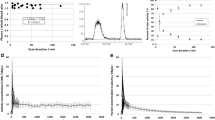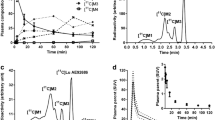Abstract
Objective
Dopamine transporter (DAT) is a reuptake carrier of dopamine at presynapse that regulates dopaminergic neural transmission. [11C]PE2I is a cocaine analog developed as a potent positron emission tomography (PET) ligand for DAT with high selectivity. The aim of this study was to evaluate the applicability of quantification methods using reference tissue models for [11C]PE2I.
Methods
Dynamic PET scans were performed in 6 young healthy male volunteers after an intravenous bolus injection of [11C]PE2I. Metabolite-corrected arterial plasma-input functions were obtained. Compartment model analysis and plasma-input Logan analysis were performed to determine the kinetic parameters and distribution volume (V T). The distribution volume ratio (DVR) was calculated as the ratio of V T in the cerebral region to that in the cerebellum. DVRs were also determined by the original multilinear reference tissue model method (MRTMo) and the simplified reference tissue model method (SRTM), comparing the results with those obtained from graphical analysis using arterial input function. To estimate errors in DVR calculated using the reference tissue model, a simulation study that focused on cerebellar kinetics and scan duration was performed.
Results
The highest [11C]PE2I binding was observed in the striatum, followed by the midbrain and thalamus. The 2-tissue model was preferable to the 1-tissue model for describing the [11C]PE2I kinetics in the cerebellum. Both the measured and 90-min simulated data showed that reference tissue models caused an underestimation of DVR in the striatum. The simulation showed that 90-min scan duration was insufficient when cerebellar kinetics was described as a 1-tissue model. Nevertheless, DVR values determined by MRTMo and SRTM were in good agreement with those by the graphical approach in other lower binding regions.
Conclusion
Due to the [11C]PE2I kinetics in the cerebellum and limited scan duration for 11C, MRTMo and SRTM underestimated the striatal DVR. Despite this limitation, the present study demonstrated the applicability of reference tissue models. Since DAT in the midbrain and thalamus is of interest in the pathophysiology of neuropsychiatric disease, this noninvasive quantitative analysis will be useful for clinical investigations.







Similar content being viewed by others
References
Fowler JS, Volkow ND, Wolf AP, Dewey SL, Schlyer DJ, Macgregor RR, et al. Mapping cocaine binding sites in human and baboon brain in vivo. Synapse. 1989;4(4):371–7.
Hantraye P, Brownell AL, Elmaleh D, Spealman RD, Wullner U, Brownell GL, et al. Dopamine fiber detection by [11C]-CFT and PET in a primate model of Parkinsonism. Neuroreport. 1992;3(3):265–8.
Wong DF, Yung B, Dannals RF, Shaya EK, Ravert HT, Chen CA, et al. In vivo imaging of baboon and human dopamine transporters by positron emission tomography using [11C]WIN 35, 428. Synapse. 1993;15(2):130–42.
Muller L, Halldin C, Farde L, Karlsson P, Hall H, Swahn CG, et al. [11C] beta-CIT, a cocaine analogue. Preparation, autoradiography and preliminary PET investigations. Nucl Med Biol. 1993;20(3):249–55.
Halldin C, Farde L, Lundkvist C, Ginovart N, Nakashima Y, Karlsson P, et al. [11C]beta-CIT-FE, a radioligand for quantitation of the dopamine transporter in the living brain using positron emission tomography. Synapse. 1996;22(4):386–90.
Ding YS, Fowler JS, Volkow ND, Gatley SJ, Logan J, Dewey SL, et al. Pharmacokinetics and in vivo specificity of [11C]dl-threo-methylphenidate for the presynaptic dopaminergic neuron. Synapse. 1994;18(2):152–60.
Goodman MM, Kilts CD, Keil R, Shi B, Martarello L, Xing D, et al. 18F-labeled FECNT: a selective radioligand for PET imaging of brain dopamine transporters. Nucl Med Biol. 2000;27(1):1–12.
Fischman AJ, Bonab AA, Babich JW, Livni E, Alpert NM, Meltzer PC, et al. [11C, 127I] altropane: a highly selective ligand for PET imaging of dopamine transporter sites. Synapse. 2001;39(4):332–42.
Emond P, Garreau L, Chalon S, Boazi M, Caillet M, Bricard J, et al. Synthesis and ligand binding of nortropane derivatives: N-substituted 2beta-carbomethoxy-3beta-(4′-iodophenyl)nortropane and N-(3-iodoprop-(2E)-enyl)-2beta-carbomethoxy-3beta-(3′,4′-disubstituted phenyl)nortropane. New high-affinity and selective compounds for the dopamine transporter. J Med Chem. 1997;40(9):1366–72.
Chalon S, Hall H, Saba W, Garreau L, Dolle F, Halldin C, et al. Pharmacological characterization of (E)-N-(4-fluorobut-2-enyl)-2beta-carbomethoxy-3beta-(4′-tolyl)nortropane (LBT-999) as a highly promising fluorinated ligand for the dopamine transporter. J Pharmacol Exp Ther. 2006;317(1):147–52.
Halldin C, Erixon-Lindroth N, Pauli S, Chou YH, Okubo Y, Karlsson P, et al. [11C]PE2I: a highly selective radioligand for PET examination of the dopamine transporter in monkey and human brain. Eur J Nucl Med Mol Imaging. 2003;30(9):1220–30.
Leroy C, Comtat C, Trebossen R, Syrota A, Martinot JL, Ribeiro MJ. Assessment of 11C-PE2I binding to the neuronal dopamine transporter in humans with the high-spatial-resolution PET scanner HRRT. J Nucl Med. 2007;48(4):538–46.
Prunier C, Bezard E, Montharu J, Mantzarides M, Besnard JC, Baulieu JL, et al. Presymptomatic diagnosis of experimental Parkinsonism with 123I-PE2I SPECT. Neuroimage. 2003;19(3):810–6.
Prunier C, Payoux P, Guilloteau D, Chalon S, Giraudeau B, Majorel C, et al. Quantification of dopamine transporter by 123I-PE2I SPECT and the noninvasive Logan graphical method in Parkinson’s disease. J Nucl Med. 2003;44(5):663–70.
Jucaite A, Fernell E, Halldin C, Forssberg H, Farde L. Reduced midbrain dopamine transporter binding in male adolescents with attention-deficit/hyperactivity disorder: association between striatal dopamine markers and motor hyperactivity. Biol Psychiatry. 2005;57(3):229–38.
Poyot T, Conde F, Gregoire MC, Frouin V, Coulon C, Fuseau C, et al. Anatomic and biochemical correlates of the dopamine transporter ligand 11C-PE2I in normal and Parkinsonian primates: comparison with 6-[18F]fluoro-l-dopa. J Cereb Blood Flow Metab. 2001;21(7):782–92.
Arakawa R, Ichimiya T, Ito H, Takano A, Okumura M, Takahashi H, et al. Increase in thalamic binding of [11C]PE2I in patients with schizophrenia: a positron emission tomography study of dopamine transporter. J Psychiatr Res. 2009;43(15):1219–23.
Pinborg LH, Videbaek C, Svarer C, Yndgaard S, Paulson OB, Knudsen GM. Quantification of [123I]PE2I binding to dopamine transporters with SPET. Eur J Nucl Med Mol Imaging. 2002;29(5):623–31.
Pinborg LH, Ziebell M, Frokjaer VG, de Nijs R, Svarer C, Haugbol S, et al. Quantification of 123I-PE2I binding to dopamine transporter with SPECT after bolus and bolus/infusion. J Nucl Med. 2005;46(7):1119–27.
Delorenzo C, Kumar JD, Zanderigo F, Mann JJ, Parsey RV. Modeling considerations for in vivo quantification of the dopamine transporter using [11C]PE2I and positron emission tomography. J Cereb Blood Flow Metab. 2009;29(7):1332–45.
Hirvonen J, Johansson J, Teras M, Oikonen V, Lumme V, Virsu P, et al. Measurement of striatal and extrastriatal dopamine transporter binding with high-resolution PET and [11C]PE2I: quantitative modeling and test–retest reproducibility. J Cereb Blood Flow Metab. 2008;28(5):1059–69.
Jucaite A, Odano I, Olsson H, Pauli S, Halldin C, Farde L. Quantitative analyses of regional [11C]PE2I binding to the dopamine transporter in the human brain: a PET study. Eur J Nucl Med Mol Imaging. 2006;33(6):657–68.
Lammertsma AA, Hume SP. Simplified reference tissue model for PET receptor studies. Neuroimage. 1996;4(3 Pt 1):153–8.
Ichise M, Ballinger JR, Golan H, Vines D, Luong A, Tsai S, et al. Noninvasive quantification of dopamine D2 receptors with iodine-123-IBF SPECT. J Nucl Med. 1996;37(3):513–20.
Huang SC, Barrio JR, Phelps ME. Neuroreceptor assay with positron emission tomography: equilibrium versus dynamic approaches. J Cereb Blood Flow Metab. 1986;6(5):515–21.
Innis RB, Cunningham VJ, Delforge J, Fujita M, Gjedde A, Gunn RN, et al. Consensus nomenclature for in vivo imaging of reversibly binding radioligands. J Cereb Blood Flow Metab. 2007;27(9):1533–9.
Mintum MA, Raichle ME, Kilbourn MR, Wooten GL, Welch MJ. A quantitative model for the in vivo assessment of drug binding sites with positron emission tomography. Ann Neurol. 1984;15:217–27.
Akaike H. A new look at the statistical model identification. IEEE Trans Automat Control. 1974;19:716–23.
Logan J, Fowler JS, Volkow ND, Wolf AP, Dewey SL, Schlyer DJ, et al. Graphical analysis of reversible radioligand binding from time–activity measurements applied to [N-11C-methyl]-(−)-cocaine PET studies in human subjects. J Cereb Blood Flow Metab. 1990;10(5):740–7.
Hurley MJ, Mash DC, Jenner P. Markers for dopaminergic neurotransmission in the cerebellum in normal individuals and patients with Parkinson’s disease examined by RT-PCR. Eur J Neurosci. 2003;18(9):2668–72.
Suzuki K, Sasaki M, Kubodera A. Approach to ultra high specific activity for 11C-labeled compounds. Synthesis of [11C]FLB 457 and [11C]Ro-15–4513. J Labelled Comp Radiopharm. 1999;42:S129–31.
Suzuki K, Inoue O, Tamate K, Mikado F. Production of 3-N-[11C]methylspiperone with high specific activity and high radiochemical purity for PET studies: suppression of its radiolysis. Int J Rad Appl Instrum A. 1990;41(6):593–9.
Brix G, Zaers J, LE Adam, Bellemann ME, Ostertag H, Trojan H, et al. Performance evaluation of a whole-body PET scanner using the NEMA protocol. National Electrical Manufacturers Association. J Nucl Med. 1997;38(10):1614–23.
Eriksson L, Holte S, Bohm C, Kesselberg M, Hovander B. Automated blood sampling system for positron emission tomography. IEEE Trans Nucl Sci. 1988;35:703–7.
Friston KJ, Holmes AP, Poline JB, Grasby PJ, Williams SC, Frackowiak RS, et al. Analysis of fMRI time-series revisited. Neuroimage. 1995;2(1):45–53.
Hall H, Halldin C, Guilloteau D, Chalon S, Emond P, Besnard J, et al. Visualization of the dopamine transporter in the human brain postmortem with the new selective ligand [125I]PE2I. Neuroimage. 1999;9(1):108–16.
Shetty HU, Zoghbi SS, Liow JS, Ichise M, Hong J, Musachio JL, et al. Identification and regional distribution in rat brain of radiometabolites of the dopamine transporter PET radioligand [11C]PE2I. Eur J Nucl Med Mol Imaging. 2007;34(5):667–78.
Slifstein M, Laruelle M. Effects of statistical noise on graphic analysis of PET neuroreceptor studies. J Nucl Med. 2000;41(12):2083–8.
Parsey RV, Slifstein M, Hwang DR, Abi-Dargham A, Simpson N, Mawlawi O, et al. Validation and reproducibility of measurement of 5-HT1A receptor parameters with [carbonyl-11C]WAY-100635 in humans: comparison of arterial and reference tissue input functions. J Cereb Blood Flow Metab. 2000;20(7):1111–33.
Ichise M, Liow JS, Lu JQ, Takano A, Model K, Toyama H, et al. Linearized reference tissue parametric imaging methods: application to [11C]DASB positron emission tomography studies of the serotonin transporter in human brain. J Cereb Blood Flow Metab. 2003;23(9):1096–112.
Acknowledgments
This study was supported by a consignment expense for the Molecular Imaging Program on “Research Base for PET Diagnosis” from the Ministry of Education, Culture, Sports, Science and Technology (MEXT), Japanese Government. The authors are thankful to Ms. Yoshiko Fukushima for organization of the clinical study and to the staff of the PET facility for their clinical assistance. We are also grateful to Dr. Masanori Ichise for his professional advice regarding the use of MRTMo, Prof. Adriaan A. Lammertsma for his kind assistance with the derivation of SRTM for DVR and to Dr. Mika Naganawa for constructive comments in the preparation of the manuscript.
Author information
Authors and Affiliations
Corresponding author
Rights and permissions
About this article
Cite this article
Seki, C., Ito, H., Ichimiya, T. et al. Quantitative analysis of dopamine transporters in human brain using [11C]PE2I and positron emission tomography: evaluation of reference tissue models. Ann Nucl Med 24, 249–260 (2010). https://doi.org/10.1007/s12149-010-0364-z
Received:
Accepted:
Published:
Issue Date:
DOI: https://doi.org/10.1007/s12149-010-0364-z




